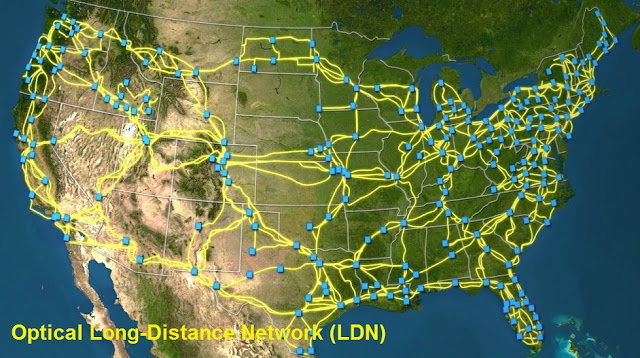 |
| LDN Network |
kilometers.
Long-distance or great distances
➤By its name long distance or great distances-Compared to other network domains, the geographical scope of Long-Distance Networks (LDN) is greater. The distance covered can span hundreds of kilometers and cross an entire country.
➤As Long-Distance Network (LDN) those optical lines interconnecting different cities.
High volume of traffic
➤High volume of traffic-Long-Distance lines are mostly located in the core network of telecom service providers.Core networks correspond to the highest level of traffic aggregation and connect the main telecom exchanges and nodes of the service provider, scattered in different and distant cities.
➤Wavelength Division Multiplexing (WDM) is the most common optical transmission technology used in Long-Distance Networks because of its outstanding data transport capabilities.
➤Three basic trends drove the boost in the core networks: increasing the use and the
quality of video transmission, the rise of cloud-based services, and the consumption of
high demand services on mobile platforms with increasing user access speeds.
quality of video transmission, the rise of cloud-based services, and the consumption of
high demand services on mobile platforms with increasing user access speeds.
Mesh topology
➤Mesh topology-Best Mesh topology only possible due to long-distance network.The traffic aggregated in core networks represents thousands or millions of user relationships.Therefore, core network nodes transport traffic destined for virtually all other core nodes, meaning that the nodes are highly interconnected.For that reason, core networks usually are arranged in a mesh topology that provides any-to-any connections among the different nodes on the network. Mesh topologies have the added benefit of providing the capability to re-route traffic at the node level in the event of failed or congested lines.
Accurate optical transmission engineering
➤Accurate optical transmission engineering-The combination of long-distances with high-speed aggregated traffic is a challenge in terms of optical transmission performance and technology.Telecommunication service providers have to face continuously growing bandwidth demands and this capacity upgrade is specifically demanding in Long-Distance networks.
➤Demanding performance in terms of channel bit rate and optical reach has leaded
core network systems to the limits of the optical technology. Therefore, fiber capacity,which once seemed to be almost infinite compared to the traffic requirements.For those reasons, Long-Distance Networks demand to be accurately engineered regarding optical transmission performance before they are actually planned and designed. Signal Regeneration, Optical Amplification, Dispersion Compensation, Noise Figure Analysis, etc. are critical functionalities to be engineered in order to ensure that the quality of the optical signal is not impaired beyond tolerable limits in any point along the optical line.
core network systems to the limits of the optical technology. Therefore, fiber capacity,which once seemed to be almost infinite compared to the traffic requirements.For those reasons, Long-Distance Networks demand to be accurately engineered regarding optical transmission performance before they are actually planned and designed. Signal Regeneration, Optical Amplification, Dispersion Compensation, Noise Figure Analysis, etc. are critical functionalities to be engineered in order to ensure that the quality of the optical signal is not impaired beyond tolerable limits in any point along the optical line.
Longest Optical Reach
➤In order to reduce network cost and power consumption, Long-Distance Networks aim to extend the Optical Reach to highest figures in order to minimize the number of costly intermediate signal regenerators.
➤The Optical Reach is the distance the optical signal can travel before the signal quality degrades to a level that necessitates electrical regeneration. The expected Optical Reach in Long-Distance Networks should be on a desirable order of 1,000 to 2,500 km, which is indeed a challenging goal for a high speed line that might be transporting several terabits per second.
➤Optical Reach is still a critical parameter because it is actually determined and engineered according to the location of the endnodes wherein the optical signal is converted into electrical and regenerated, regardless of any other optical bypass nodes existing at intermediate points.
➤One of the most important features of transport networks is their ability to preserve data
traffic even when faults occur. This feature is generally referred to as “resilience.”
traffic even when faults occur. This feature is generally referred to as “resilience.”
➤System availability and reliability are essential in core networks due to large amount of aggregated traffic carried by those lines.
➤The great geographic scope of core networks also means that getting craft personnel to an area to fix a problem may require days, and thus it is critical to design core networks with some form of redundancy in order to mitigate the impact of any line outage as much as possible. The way these extra resources are used depends strongly on network topology (rings or meshed network configurations are suitable), equipment technology and traffic protection requirements.
Today the world is really looking very small,the whole world is on one platform very easily connected to each other, its only due to Long-Distance Network. Growing bandwidth demands and this capacity upgrade is specifically demanding in Long-Distance networks.With the help of Long-Distance Network increasing the use and the quality of video transmission.




0 Comments